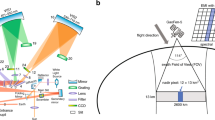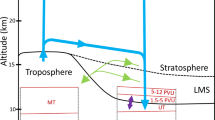Abstract
Nitrogen dioxide is important to stratospheric ozone chemistry1. The few observations of vertical distribution of the gas are reviewed elsewhere2. Most available data relate to ground-based measurements of the total amount in the vertical column. Such observations are ideally made from a high altitude site to avoid local tropospheric sources. Noxon3 observed a mean value of 5 × 1015 molecules cm–2 from Fritz Peak Observatory. Pommereau and Hauchecorne4 obtained much higher values, of a few ×1017 molecules cm–2, at Haute-Provence Observatory. Noxon et al. have reported latitudinal gradients5,6 and response to stratospheric warmings7, reporting stratospheric column values in the range 1–5 × 1015 molecules cm–2. During the past year, several series of observations have been made from a low altitude rural site in the UK. Values obtained for the vertical column were in the range 0.8–5.6 × 1016 molecules cm–2. In view of the tropospheric contribution expected at this site8, these values represent an upper limit to the stratospheric NO2 column and we show here that the values reported by Pommereau and Hauchecorne were anomalously high.
This is a preview of subscription content, access via your institution
Access options
Subscribe to this journal
Receive 51 print issues and online access
$199.00 per year
only $3.90 per issue
Buy this article
- Purchase on Springer Link
- Instant access to full article PDF
Prices may be subject to local taxes which are calculated during checkout
Similar content being viewed by others
References
Crutzen, P. J. Q. Jl R. met. Soc. 96, 320 (1970).
Drummond, J. R. & Jarnot, R. F. Proc. R. Soc. A264, 237–254 (1978).
Noxon, J. F. Science 189, 547–549 (1975).
Pommereau, J. P. & Hauchecorne, A. C. r. hébd. Séanc. Acad. Sci., Paris. B288, 135–138 (1979).
Noxon, J. F. et al. J. geophys. Res. 84, 5047–5065 (1979).
Noxon, J. F. J. geophys. Res. 84, 5067–5076 (1979).
Noxon, J. F. et al. J. geophys. Res. 84, 7883–7888 (1979).
Cox, R. A. Tellus 29, 356–362 (1977).
Harrison, A. W. Can. J. Phys. 57, 1110–1117 (1979).
Curcio, J. A. et al. Nav. Res. Lab. Rep. 4669 (1955).
Kuznetsov, G. I. & Nigmatullina, K. S. Izv. Fiz. Atmos. Okean. 13, 886–889 (1977).
Eldridge, R. G. J. atmos. Sci. 23, 605–613 (1966).
Ahlquist, N. C. & Charlson, R. J. Atmos. Envir. 3, 551–564 (1969).
Wilkerson, T. D. et al. Tech. Note BN-784 (Institute for Fluid Dynamics & Applied Mathematics, University of Maryland, 1974).
Department of the Environment Chlorofluorocarbons and Their Effect on Stratospheric Ozone (Pollution Paper No. 15, HMSO, London, 1979).
Author information
Authors and Affiliations
Rights and permissions
About this article
Cite this article
McMahon, B., Simmons, E. Ground-based measurements of atmospheric NO2 by differential optical absorption. Nature 287, 710–711 (1980). https://doi.org/10.1038/287710a0
Received:
Accepted:
Issue Date:
DOI: https://doi.org/10.1038/287710a0
This article is cited by
-
NO2 total column evolution during the 1989 spring at Antarctica Peninsula
Journal of Atmospheric Chemistry (1992)
-
Aircraft observations of solar radiation in cloud-free atmospheres
Boundary-Layer Meteorology (1984)
Comments
By submitting a comment you agree to abide by our Terms and Community Guidelines. If you find something abusive or that does not comply with our terms or guidelines please flag it as inappropriate.



